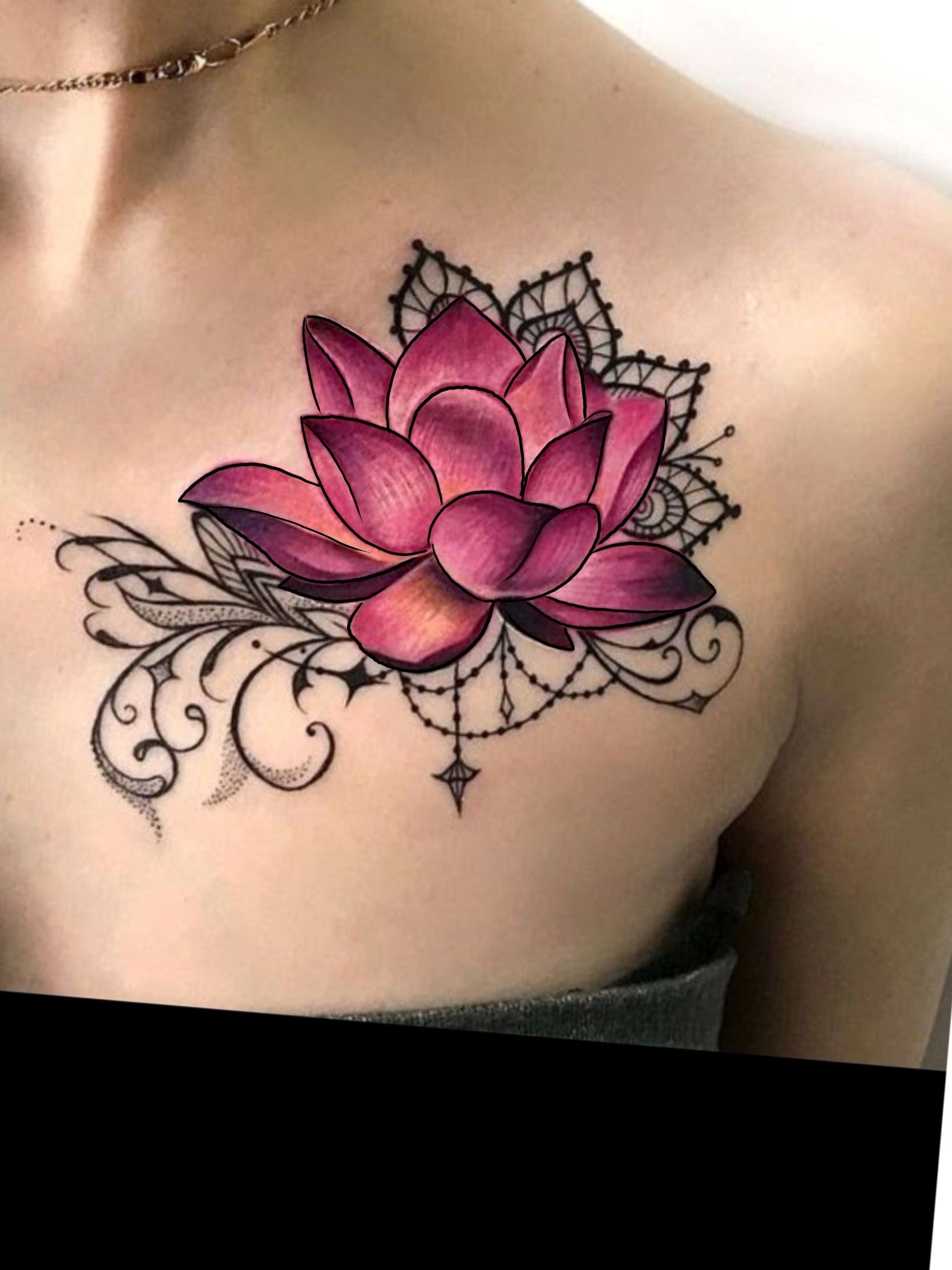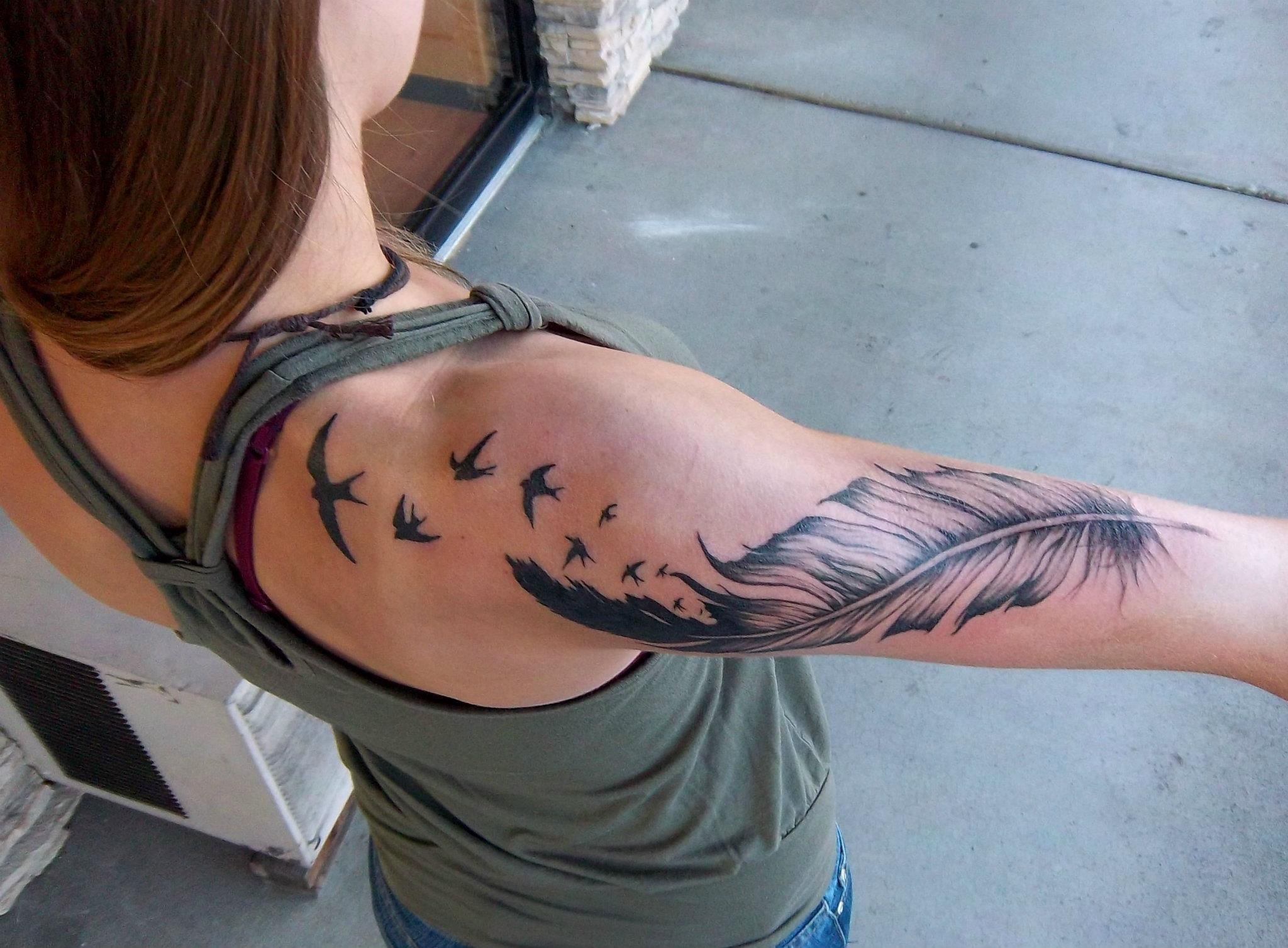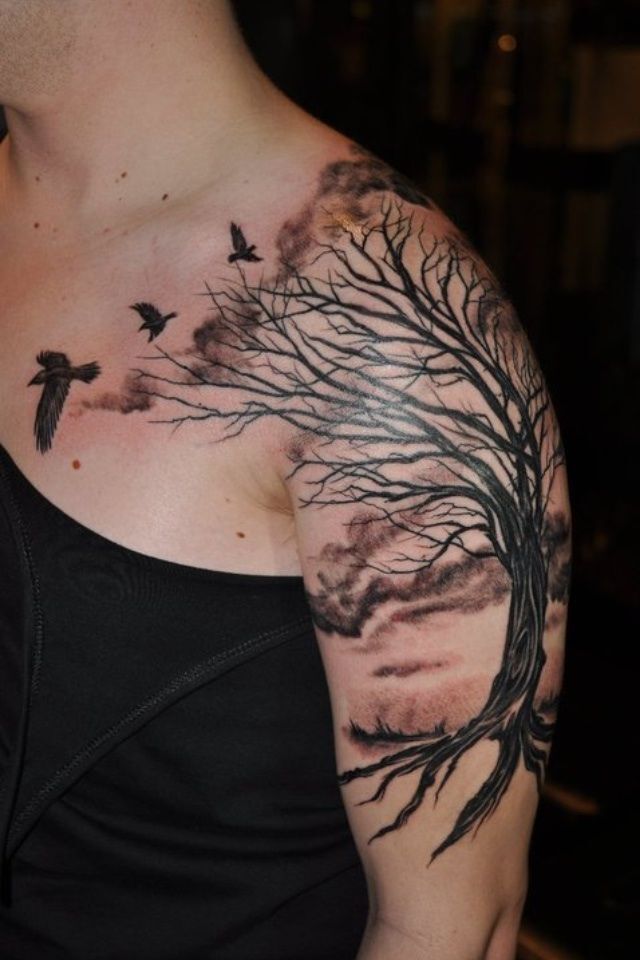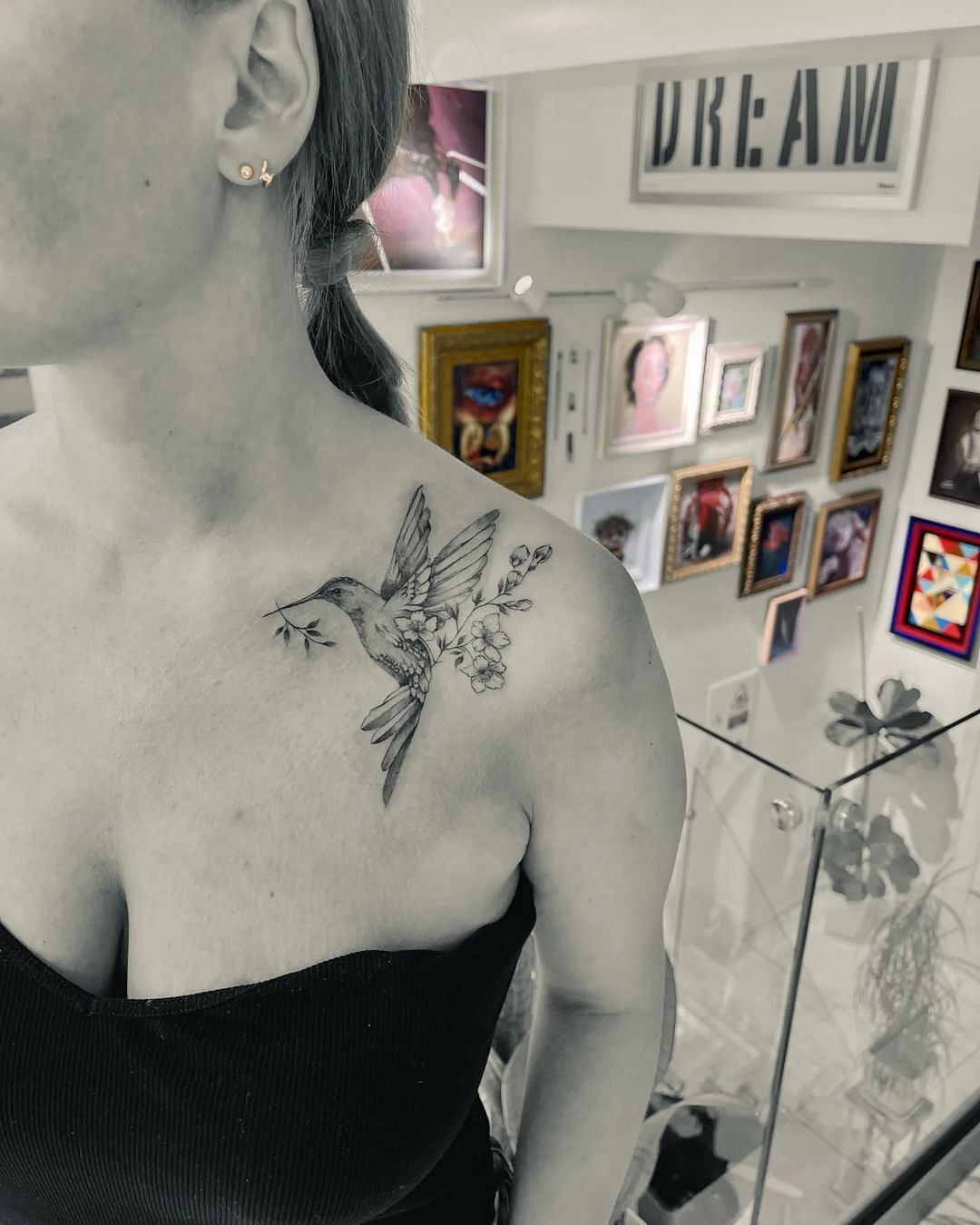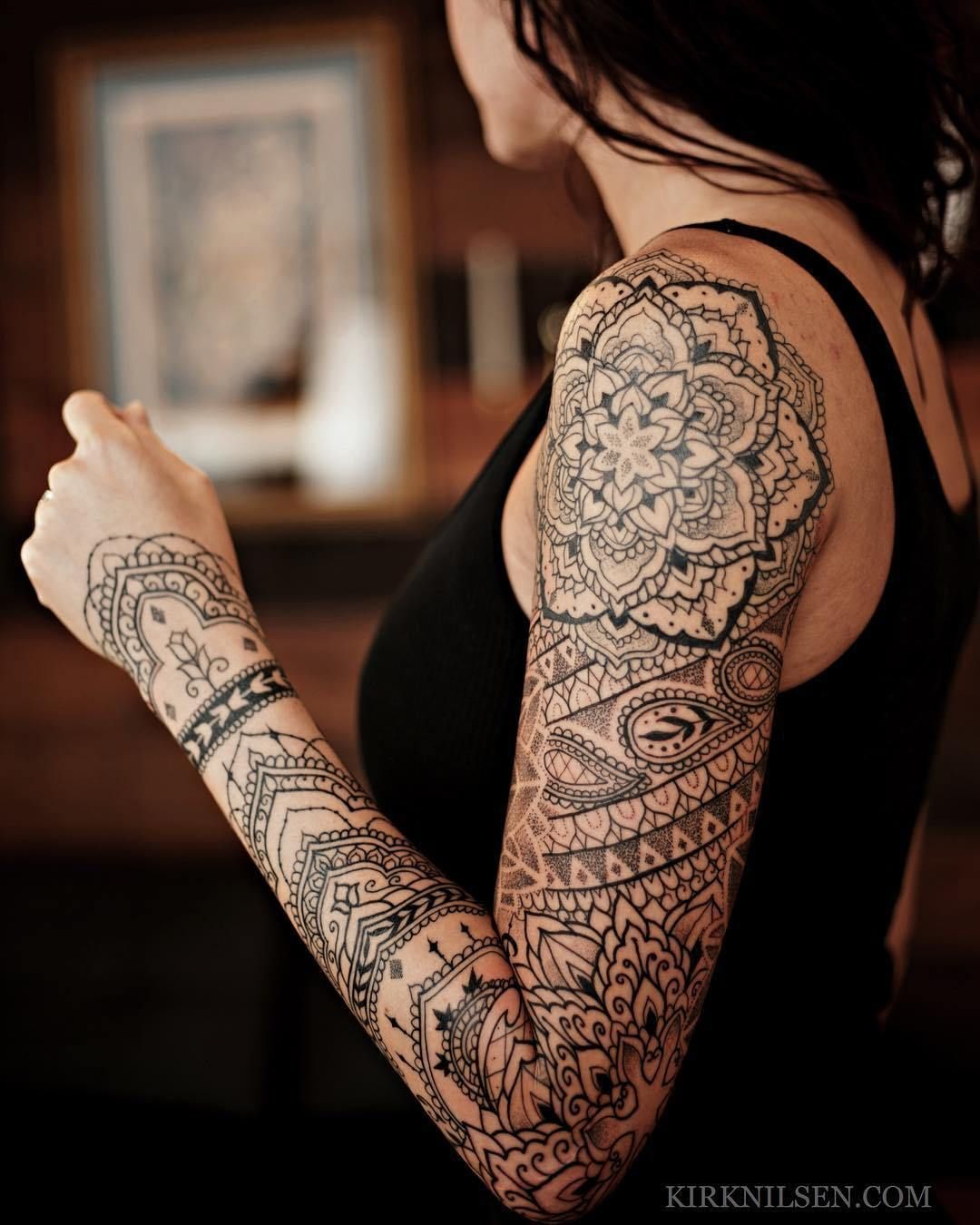Shoulder tattoos are popular for women, as they provide a unique canvas to showcase intricate designs and meaningful symbols. From delicate flowers to bold geometric patterns, shoulder tattoos can be beautiful and empowering for women. In this article, we will explore the symbolism and meaning behind shoulder tattoos for females and some of the top-rated tattoo ideas and their meanings. We will also discuss the history and origin of female shoulder tattoos and answer some common questions about the tattoo process.
Are you only interested in tattoo designs and want to skip the educational part?
No problem, we got you covered! Click HERE to get inspired.
What does the shoulder area symbolize for women?
The symbolism of the shoulder area for women can vary across cultures and contexts. Here are a few common interpretations:
Femininity and Grace: The shoulder area is often associated with femininity and grace. It is considered an attractive feature and can enhance a woman's overall appearance. In various fashion trends, off-the-shoulder or shoulder-baring outfits are seen as elegant and alluring.
Strength and Independence: Shoulders are also associated with strength and independence. Strong, well-defined shoulders can symbolize physical fitness and the ability to carry heavy burdens, both literally and metaphorically. In this sense, the shoulder area can represent a woman's resilience, determination, and ability to overcome challenges.
Vulnerability and Sensuality: The shoulder area can also symbolize vulnerability and sensuality. Exposing the shoulders can create an intimate and vulnerable impression, particularly when combined with the neck and collarbone. It can convey a sense of femininity and evoke feelings of attraction and desire.
Expression and Body Language: The shoulder area plays a crucial role in body language and non-verbal communication. Upright and open shoulders can indicate confidence and assertiveness, while slumped or rounded shoulders may suggest submissiveness or low self-esteem. The way women carry themselves and use their shoulders can send powerful messages about their personality and emotional state.
Cultural and Religious Significance: In certain cultures or religious contexts, the shoulder area may have specific symbolism. For example, in some cultures, the exposure of shoulders may be associated with modesty or immodesty, depending on societal norms and religious beliefs.
What is the meaning behind shoulder tattoos for females?
Shoulder tattoos for females can hold a variety of meanings, depending on the individual and their personal choices. Here are some common interpretations and symbolism associated with shoulder tattoos for women:
Self-expression and Individuality: Shoulder tattoos can be a form of self-expression, allowing women to showcase their unique personality, interests, or beliefs. They serve as a way to express individuality and differentiate oneself from others.
Strength and Empowerment: Shoulder tattoos can symbolize strength, resilience, and empowerment. They can serve as a reminder of personal growth, overcoming challenges, or embracing one's inner strength. Women may choose shoulder tattoos to represent their ability to shoulder burdens and rise above adversity.
Beauty and Femininity: Shoulder tattoos can enhance a woman's beauty and femininity. They can be aesthetically pleasing, accentuating the natural curves and contours of the shoulder area. Some women choose floral or intricate designs to emphasize their femininity and grace.
Personal Story or Journey: Shoulder tattoos can be a way to commemorate important life events, milestones, or personal journeys. They can represent significant moments, relationships, or achievements, serving as a permanent reminder of meaningful experiences.
Connection to Nature or Spirituality: Many women opt for shoulder tattoos inspired by nature or spirituality. These tattoos can represent a deep connection to the natural world, a particular element, or a spiritual belief system. Symbols like birds, flowers, trees, or spiritual motifs may be chosen to convey these connections.
Empathy and Compassion: Some women choose shoulder tattoos as a symbol of empathy and compassion. These tattoos may represent their desire to support and care for others, to be a shoulder to lean on, or to symbolize their role as a nurturing figure.
best shoulder tattoo ideas for women and their meanings
Shoulder tattoos can be a beautiful and meaningful way for women to express themselves and showcase their individuality. Each tattoo idea carries its own symbolism, representing personal growth, resilience, spirituality, and more.
Lotus Flower Shoulder Tattoo for women
A lotus flower tattoo on the shoulder symbolizes purity, enlightenment, and spiritual growth. It represents the journey of overcoming challenges and finding inner peace. The lotus, emerging from muddy waters to bloom into a beautiful flower, serves as a reminder of personal transformation and resilience.
Feather Shoulder Tattoo for women
A feather tattoo on the shoulder represents freedom, spirituality, and protection. It signifies the desire for independence and personal growth. The delicate nature of feathers, combined with their ability to catch the wind and soar, represents the pursuit of one's dreams and a connection to the spiritual realm.
Tree of Life Shoulder Tattoo for women
The Tree of Life tattoo on the shoulder symbolizes interconnectedness, strength, and resilience. It represents the deep roots and branches of personal connections and the balance between life, death, and renewal. This tattoo serves as a reminder of personal growth, grounding, and finding strength in one's roots.
Hummingbird Shoulder Tattoo for women
A hummingbird tattoo on the shoulder represents joy, resilience, and the ability to find happiness in small moments. It symbolizes agility, energy, and vibrant living. The hummingbird tattoo serves as a reminder to embrace life's fleeting moments, pursue one's dreams, and find beauty in the present.
Mandala Shoulder Tattoo for women
A mandala tattoo on the shoulder symbolizes harmony, balance, and unity. It represents the interconnectedness of the universe and the infinite nature of existence. The mandala tattoo serves as a reminder of self-discovery, personal transformation, and the journey towards inner peace and wholeness.
Who should get a shoulder tattoo?
Shoulder tattoos are a versatile choice that can suit a wide range of individuals. While there are no strict rules or limitations on who should get a shoulder tattoo, here are some considerations to keep in mind:
Personal Preference: Ultimately, the decision to get a shoulder tattoo rests on personal preference. If you are drawn to the idea of having a tattoo on your shoulder and feel a strong connection to the design or symbolism, then it may be a suitable choice for you.
Pain Tolerance: Tattooing can involve some discomfort, as the process typically involves the insertion of ink into the skin using needles. The shoulder area is generally considered to be a moderately painful location for tattoos due to the proximity of bones and nerve endings. If you have a lower pain tolerance, you may want to take this into account.
Lifestyle and Professional Considerations: It's important to consider your lifestyle and any professional requirements that may affect your choice to get a shoulder tattoo. Some workplaces have dress code policies that restrict visible tattoos, so you may need to consider whether a shoulder tattoo can be easily concealed when necessary.
Healing and Aftercare: Proper healing and aftercare are crucial for any tattoo. The shoulder area is generally well-suited for tattoo healing, as it is less prone to rubbing against clothing or experiencing excessive movement. However, it's important to follow the aftercare instructions provided by your tattoo artist to ensure optimal healing and long-term results.
Commitment: Tattoos are permanent, so it's important to consider the long-term commitment and potential impact on your body image. Make sure you are comfortable with the design and meaning of your chosen tattoo as it will be a part of you for life.
@tats_by_ronn #floral #tattoo #flowers #art #shouldertattoo #ink #tattoogirl #tattooideas #tattooartist #tattooartist #nctattooartist #nc #nctattooist ♬ Insane - Summer Walker
General Breakdown Of Tattoo Pain Levels On Different Body Parts
Here is a breakdown of the different tattoo pain levels:
- Low: This level of pain is generally described as a mild discomfort or tickling sensation. It is similar to the sensation of getting a light scratch or scrape.
- Moderate: This level of pain is generally described as a moderate discomfort or aching sensation. It is similar to the sensation of getting a deep scratch or scrape or being pinched.
- High: This level of pain is generally described as a strong discomfort or throbbing sensation. It is similar to the sensation of getting a burn or being stung by a bee.
It's important to note that pain tolerance is highly individual and can vary greatly from person to person. Some people may find certain body parts more or less painful than others, and the same body part can be more or less painful for different people. Additionally, the level of pain can be affected by factors such as the size and location of the tattoo, the skill of the tattoo artist, and the individual's own pain threshold.
Tattoo placement pain level chart
Body Part | Pain Level | Explanation |
Forehead | Low | The forehead has few nerve endings, so it is not a particularly painful area. |
Eyebrows | Low | The eyebrows have few nerve endings, so the pain level is relatively low. |
Ear | Low | The ear is a relatively thin and fleshy area, so the pain level is low. |
Nostril | Low | The nostril is a small area with thin skin, so the pain level is low. |
Lip | Low to Moderate | The lip has more nerve endings than some other areas, so it may be slightly more painful. |
Cheek | Low to Moderate | The cheek has a moderate amount of nerve endings, so it may be slightly more painful. |
Moderate | The neck has a moderate amount of nerve endings, so it may be slightly more painful. | |
Moderate to High | The chest has a high concentration of nerve endings, so it can be quite painful. | |
Abdomen | High | The abdomen has a high concentration of nerve endings, so it can be quite painful. |
Back | High | The back has a high concentration of nerve endings, so it can be quite painful. |
Shoulders | High | The shoulders have a high concentration of nerve endings, so they can be quite painful. |
Upper Arms | Moderate to High | The upper arms have a moderate to high concentration of nerve endings, so they can be somewhat painful. |
Elbows | High | The elbows have a high concentration of nerve endings, so they can be quite painful. |
Forearms | Moderate | The forearms have a moderate concentration of nerve endings, so they are not as painful as some other areas. |
Hands | High | The hands have a high concentration of nerve endings, so they can be quite painful. |
Lower Arms | Low to Moderate | The lower arms have a lower concentration of nerve endings, so they are not as painful as some other areas. |
Wrists | Low | The wrists have a low concentration of nerve endings, so they are not very painful. |
Lower Back | High | The lower back has a high concentration of nerve endings, so it can be quite painful. |
Buttocks | High | The buttocks have a high concentration of nerve endings, so they can be quite painful. |
Thighs | High | The thighs have a high concentration of nerve endings, so they can be quite painful. |
Knees | High | The knees have a high concentration of nerve endings, so they can be quite painful. |
Calves | Low to Moderate | The calves have a low to moderate concentration of nerve endings, so they are not as painful as some other areas. |
Ankles | Low | The ankles have a low concentration of nerve endings, so they are not very painful. |
Tattoo aftercare tips
Before getting a tattoo:
Choose a reputable tattoo artist and parlor. Research the artist's portfolio and read reviews from previous clients.
Consult with the artist about the design and placement of the tattoo.
Make sure you are in good health. If you have any medical conditions or are taking any medications that may affect your ability to heal, be sure to let your tattoo artist know.
Consider using a numbing cream to reduce pain during the tattooing process. These creams contain a numbing agent (such as lidocaine) that can be applied to the skin before the tattoo is done. It's important to follow the instructions on the numbing cream and to only use it as directed.
Avoid alcohol, caffeine, and other substances that can thin your blood for at least 24 hours before getting a tattoo.
Eat a healthy meal before your tattoo session to ensure that your blood sugar is stable.
Wear loose, comfortable clothing that allows easy access to the area being tattooed.
After getting a tattoo:
Follow the aftercare instructions provided by your tattoo artist. These may include:
Keeping the tattoo clean and covered with a bandage for the first few hours after getting tattooed.
Washing the tattoo with lukewarm water and a mild soap (such as unscented, antimicrobial soap) and patting it dry with a clean towel.
Applying a thin layer of tattoo ointment or lotion (such as A&D or Aquaphor) to the tattoo and covering it with a clean bandage or wrap.
Repeating this process for the first few days, or until the tattoo has fully scabbed over.
Avoid soaking the tattoo in water for the first week, such as in a bath or pool.
Avoid picking or scratching at the scabs, as this can cause the tattoo to fade or become infected.
Avoid exposure to direct sunlight or tanning beds for at least 2-4 weeks.
If you experience any redness, swelling, or unusual discharge, contact your tattoo artist or a healthcare professional.
Overall, it's important to keep your tattoo clean and moisturized during the healing process to ensure that it heals properly and looks its best. Using a numbing cream can help reduce pain during the tattooing process, but it's important to use it as directed and to follow all aftercare instructions to ensure that your tattoo heals properly.
People Also Ask:
Will a shoulder tattoo hurt?
The level of pain associated with a shoulder tattoo can vary based on individual pain tolerance and the specific location on the shoulder. Some people may find the top or outer shoulder more sensitive, while others may find the inner shoulder more tolerable. It is important to remember that all tattoos involve some discomfort, but most people find the pain manageable.
How much will a shoulder tattoo cost?
The cost of a shoulder tattoo can vary greatly depending on the size, complexity, and location of the tattoo and the hourly rate of the tattoo artist. It is always a good idea to shop around and get quotes from multiple artists before deciding.
Can I cover up a shoulder tattoo?
In most cases, a shoulder tattoo can be covered with another tattoo or makeup. However, it is important to remember that cover-up tattoos can be more challenging and time-consuming than traditional tattoos and may require additional sessions to achieve the desired result. It is always a good idea to consult a tattoo artist before deciding on a cover-up tattoo.
How long does a shoulder tattoo take to heal?
Most shoulder tattoos will take about two to three weeks to heal fully. It is important to follow proper aftercare instructions, including keeping the tattoo clean and moisturized and avoiding activities that could irritate or damage the tattoo.
Can I swim with a new shoulder tattoo?
It is generally recommended to avoid swimming or submerging a new tattoo in water for at least two weeks to allow the tattoo to properly heal. After this time, it is generally safe to swim with a shoulder tattoo, but it is always a good idea to avoid exposing the tattoo to prolonged periods of direct sunlight or chlorine, as these can fade or damage the tattoo.
Watch A Full Time-Lapse Video Of A shoulder Tattoo Done By A Pro:
200 women Shoulder Tattoo Ideas For Your Inspiration
Final thoughts:
Shoulder tattoos are a popular and stylish choice for women, offering a unique canvas to showcase intricate designs and meaningful symbols. From delicate flowers to bold geometric patterns, shoulder tattoos can be beautiful and empowering. Whether you choose a tattoo to honor your heritage, pay tribute to loved ones, or express your values and beliefs, a shoulder tattoo can be a meaningful and enduring way to celebrate your unique identity.

